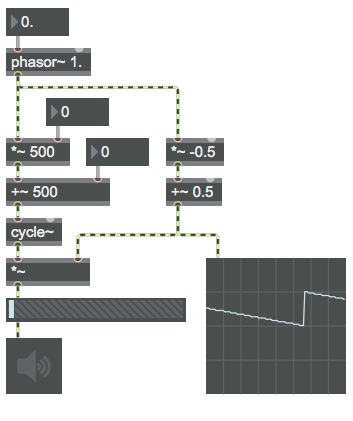Using phasor~ directly as a control signal

If you need a linear signal that repeats at a specific rate, phasor~ can be scaled and offset to provide a repeating line from one signal value to another. In this example, we use phasor~ to directly control both frequency and amplitude of an oscillator.
Since phasor~ ramps from 0 to (almost) 1, it would normally create a crescendo in amplitude, and indeed it can be useful for that purpose over long periods of time as a control signal for other control signals. A more normal amplitude envelope for a single note, however, goes quickly to a peak amplitude and then gradually decreases to 0 over the course of the note. So in this patch we multiply the phasor~ signal by -0.5, which causes it to ramp from 0 to -0.5, and then we add 0.5 to that so that it is now ramping from 0.5 to 0. (Notice that the leap up from 0 to 0.5 is instantaneous, though, causing a click in this case. A more sophisticated program might do something to smooth that transition.) We use a similar scaling and offsetting procedure for the control of frequency of the cycle~. We multiply the phasor~'s output by 500 then add 500 to that so that the result is a ramp that goes from 500 to 1000 (a number that we use as Hz in the cycle~). You can experiment with other rate settings for the phasor~ and other frequency ranges for the cycle~.